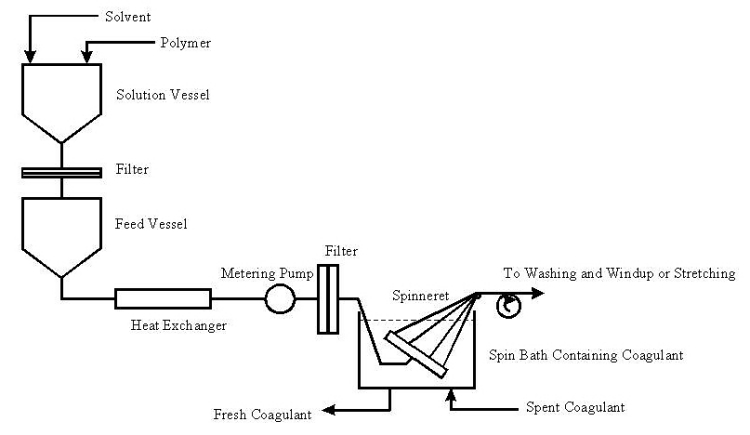
Wet spinning is the most complex of the spinning
techniques. Some wet spinning process require the polymer solution
to be kept above or below ambient temperature and thus a heat exchanger
is used. The spinnerets are immersed in tanks containing the coagulation
into which the filaments are extruded. The extrusion direction is
variable from vertically upwards to horizontal. The spinnerets used
in wet-spinning can have up to 2,000 holes for commercial applications.
However, conventional wet spinning is the slowest of the principal processes
having windup speeds to approximately 150 m/min.
This process is based on precipitation only, without
chemical regeneration. The solvent diffuses out of the extrudate
into the bath, and a non-solvent diffuses from the bath into the extrudate.
The polymer precipitates as a gel initially at the extrudate-coagulant
interface but progressively throughout the extrudate. The coagulation
rate has a large influence on the gel structure and the final fiber properties.
The processing variables are concentration and temperature of the spinning
solution, composition, concentration and temperature of the spin bath;
and the stretch applied during spinning. These conditions lower the
spin-bath temperature, and lower stretch during spinning. These conditions
lead to greater homogeneity and higher orientability in a subsequent stretching
or drawing process and hence to better tensile properties. The spin
bath and spinning solutions may include small amounts of modifying agents
that tend to improve homogeneity of the spun yarn. The coagulated
filaments pass over a guide to driven rollers. The steps succeeding
coagulation vary according to the product but typically include washing,
stretching, finish application, drying, crimping, controlled relaxation
for a tow, plus cutting for a staple fiber product.
A table of typical wet-spinning solvents
and coagulants.
Ref:
Kroschwitz, Jacqueline I. Encyclopedia of Polymer Science and
Engineering. Second Edition, Vol. 6. John Wiley & Sons. New York.
1986 pp. 812-815.